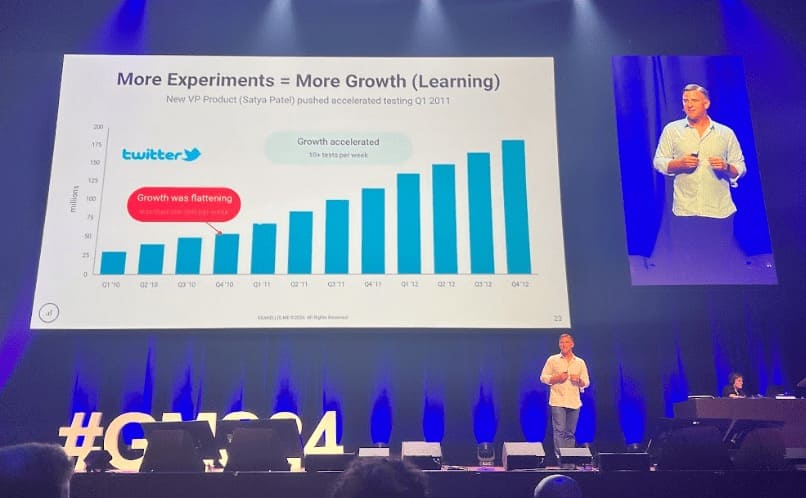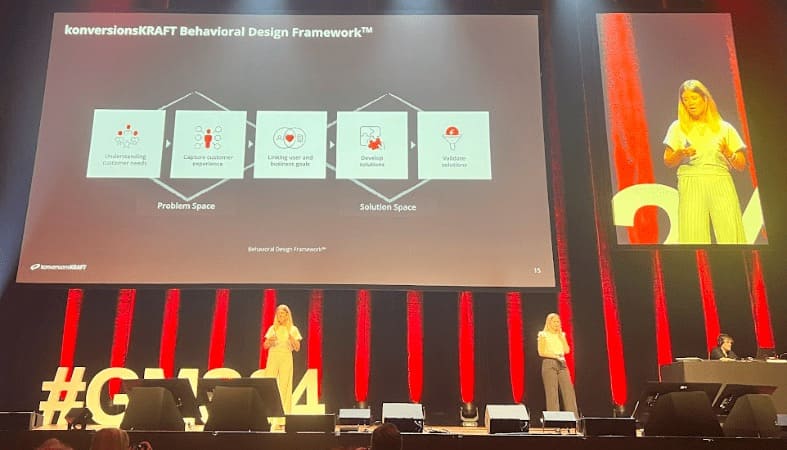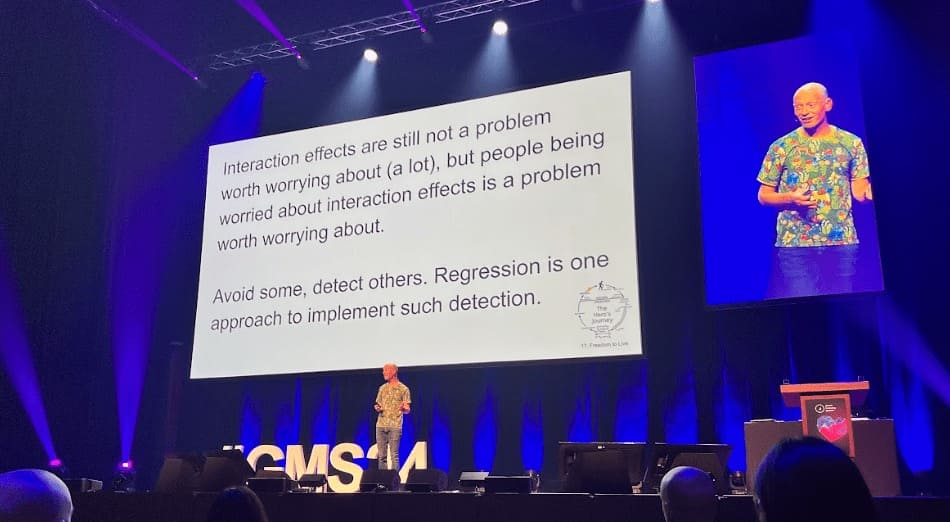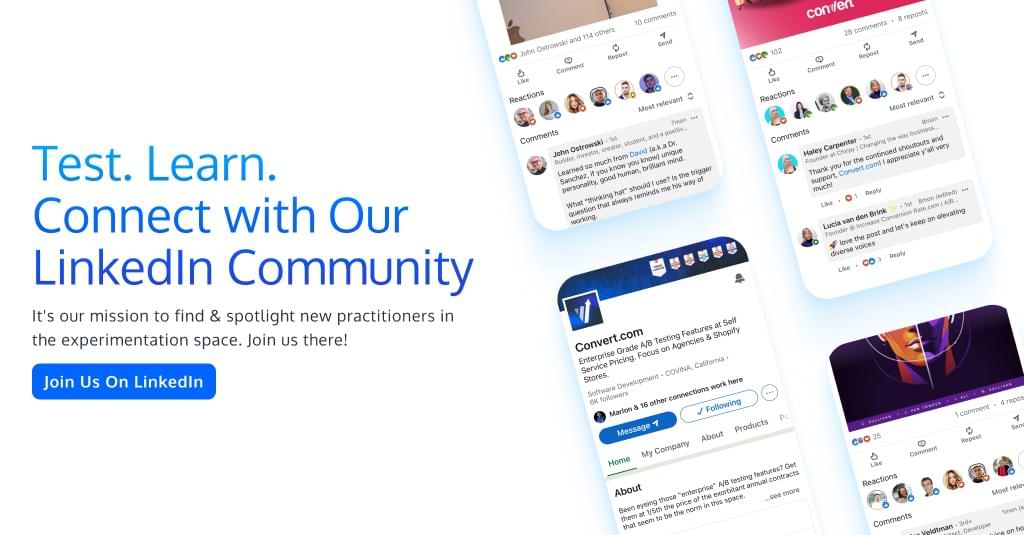Is This the Future of Growth Marketing? What I Learned from Each GMS 2024 Speaker
On the 19th of June, I had the opportunity to attend a conference I have only heard great things about, Growth Marketing Summit (or Growth Minded Superheroes!). Not only was this my first time at the conference but also my first time in Frankfurt. With the Euros in Germany, the sunny streets of the city were packed with football fans more likely to be disappointed than me.
This article will take you through all the insightful talks lined up by André, Julia, and the konversionsKRAFT team. The quality of the speakers is a testament to the effort they put into this event.
So, my round-up of what we saw this year…
1. How Disappointment Affects Your Users, Why It’s Bad for Your Business & What You Can Do About It
Speaker: Michael Aagaard, CRO Expert & Keynote Speaker
Michael’s keynote speech was an entertaining and insightful story about the science of disappointment. He began with an anecdote from his childhood about buying sea monkeys, sharing his disappointment gap—the disparity between his expectations and reality.
In an analysis of the negative business impacts of disappointment, Michael presented startling research: 93% of users reported that disappointment negatively affected their behavior. He explained that this response is a neurochemical event known as “reward prediction error,” which happens when there’s a mismatch between received and predicted outcomes.
The key points in his presentation were:
- We underestimate how much disappointment actually affects behaviour; scientific literature shows it impacts memory, reactions and learning.
- Humans have what may seem intense or exaggerated reactions to disappointment—it’s just the way we’re wired.
- What we often perceive as ‘friction’ is actually the emotional pain of our expectations not living up to reality.
How do we become more aware of where we could be disappointing users?
- Use review mining and analysis to identify and address common pain points.
- In a usability test, go beyond asking, “What was your experience like”. Use a pre-test expectation measurement and a post-test experience measurement. For example, ask, “On a scale of 1-5, how difficult do you think this will be?” before the test, and then ask how difficult it was in the post-test measurement.
- A discrepancy between these measurements signals potential disappointment.
- Take disappointment into consideration when implementing changes on your site.
Michael concluded by explaining that disappointment destroys conversions, trust, loyalty, and brand reputation, urging businesses to mind the expectation gap when implementing changes and carrying out user research.

2. Optimizing Optimization for More ROI
Speaker: Luke Frake, Experimentation Lead User Growth at Spotify
Luke talked about how automation in experimentation can benefit us all, emphasizing its effectiveness in variant checking, automated error detection and Sample Ratio Mismatch (SRM) checks for accurate results.
He stressed the democratisation of data, pointing to Spotify’s use of Backstage to make data accessible to all team members, thereby reducing reliance on gut feelings and freeing up key players for more strategic tasks. This is a hot topic as we saw in the Convert survey at ExElite this year, where data availability was identified as a major challenge for those looking to embed an experimentation culture.
Pivoting to long-term thinking, Luke also advocated for running multiple experiments to drive sustained growth rather than focusing on single outcomes. By avoiding false starts and keeping users at the heart of everything, he showed how democratizing data and thorough analysis can significantly enhance the experimentation culture and overall ROI of running tests.
Key takeaways:
- Automate Processes: Streamline steps to scale effectively; think tagging and issue alerting.
- Democratise Data: Ensure everyone has access to and understands the data.
- User-Centric Focus: Prioritise long-term positive impacts for users over short-term gains.
3. Your Senior Leaders Don’t Care About Experimentation
Speaker: Shagun Aulakh, Director of Product Management & Experimentation at American Express
Shagun tackled the difficult issue of fostering a culture of experimentation within organisations. She exposed a significant gap between leadership’s perceived support for experimentation and the reality of its implementation. Leaders often claim to champion experimentation and tolerate failure, yet often prioritise predictable outcomes over innovative efforts. This discrepancy, Shagun noted, stems from misaligned expectations and a lack of understanding about what it takes to build a Center of Excellence (CoE) or drive skill levels across experiment teams.
Shagun shared that leadership underestimates the complexity and investment required for successful experimentation. They may underestimate its impact, baulk at costs, fail to grasp the process fully, or juggle competing priorities.
To bridge this gap, Shagun suggested:
- Listening more, especially in one-on-one meetings with leaders
- Asking open and discovery questions to reveal their priorities and concerns
- Being humble and recognising the value of their experience—what she referred to as “Valuing HiPPOs” (Highest Paid Person’s Opinion)
- Focusing on outcomes, aligning the conversation around North Star metrics that drive desired outcomes.
Shagun shared that building a true culture of experimentation comes from consistent actions and practices within teams, not off-the-shelf solutions. It’s something you earn, not purchase. By aligning experimentation goals with broader business objectives and actively engaging leadership, organisations can hurdle barriers to creating a successful experimentation culture. This alignment echoes Speero’s maturity report which showed that 67% of transformative organisations strongly agree that performance measurement goals could correlate with the organisation’s main goals.
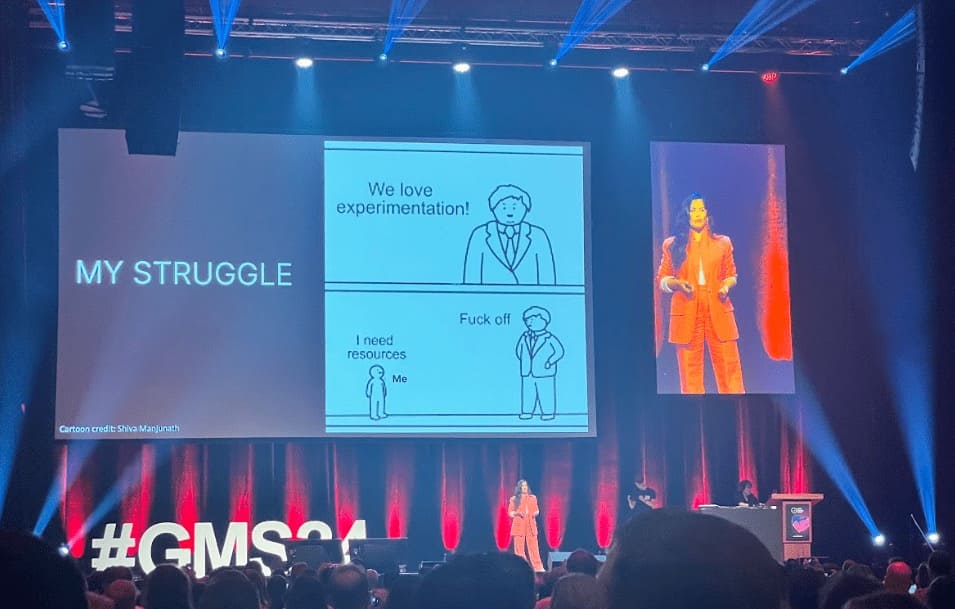
4. Hacking Growth: How Today’s Fastest-Growing Companies Drive Breakout Success
Speaker: Sean Ellis, Author of “Hacking Growth” & Founder of GrowthHackers.com
In his talk, Sean shared insights on how the world’s top companies use growth hacking techniques to achieve standout success.
He explained that traditional companies often fall short of their growth potential due to slow adaptation.
The solution? Start with value delivery and quantify it with a North Star metric. Think Uber’s weekly rides or Slack’s daily active users. The key to sustainable growth, he said, is delivering “must-have” value.
Successful growth hacking requires rapid, systematic testing and strong cross-functional collaboration. Sean dropped a pro tip for measuring product-market: ask users how they’d feel if they could no longer use the product.
Focus on those who’d be “very disappointed”—about 40% of users need to feel this way for true product-market fit and sustainable growth.
5. Continuous Discovery – How Product & CRO Could Benefit from Each Other
Speakers: Stefanie Grimmling & Anastasia Shvedova, Management Team Members at konversionsKRAFT
Stefanie and Anastasia explored the synergy between product management and conversion rate optimization, emphasising the importance of continuous discovery.
They pointed out that product teams often lack the time to understand users, leading to biases such as false consensus and confirmation bias.
They introduced a behavioural design framework that integrates user insights into daily routines. A case study with Villeroy & Boch showcased how the company initially misidentified user needs in bathroom planning but, through deep interviews and prototype testing, discovered the real issues and developed effective solutions.
Stefanie and Anastasia provided three key takeaways:
- Frame problems correctly to avoid solving the wrong puzzle.
- Start small with product discovery, treating solutions as hypotheses.
- Combine multiple methods for efficient and effective discovery.
They stressed the importance of dedicating time to product discovery to ensure businesses truly understand their users and create valuable products.
Stefanie and Anastasia pulled off the most seamless two-person talk I’ve ever seen—let’s all hope they share the stage again soon! They’re looking for feedback on their Product Discovery Methods cheat sheet so be sure to reach out to them.
6. How AI Will Impact User Experiences and What You Should Do About It Today
Speaker: Ioana Teleanu, Senior Product Designer AI at Miro, Founder + Design Consultant, Educator & Speaker at UX Goodies
Ioana explored the evolving role of AI in user experiences, emphasising the designer’s responsibility in shaping future interactions. While AI is currently in a phase of disillusionment, Ioana believes it holds significant potential for future stability and integration.
She stressed that AI should be viewed as a tool to enhance, not replace, human creativity and problem-solving. One interesting point in Ioana’s talk was about the twinkly, magical and purple visual cues often used to signify AI integration (see below).
She highlighted several key challenges in AI design: bias baked into AI systems, safety and security concerns, unpredictability of AI outcomes, and the need for trust and transparency.
Ioana advocated for a user-centred approach, designing AI systems with people in mind and making AI tools accessible to reduce societal disparities.
She proposed principles for ethical AI design, including starting with user needs, ensuring safety and control, and building trust through explainability. She envisions a future where AI enhances product relevance, personalisation, and accessibility, urging designers to think critically about the integration of AI into their work.
7. Design for Impact: Simple Frameworks for Better Results
Speaker: Erin Weigel, Senior Group Product Design Manager at Deliveroo
Erin began her talk with a historical anecdote about Ronald Fisher, who discovered the importance of robust experimental design after finding decades of research data to be flawed due to poor methodology. This set the stage for her main point: the power of convergent design, which integrates design, science, and business to drive meaningful improvements rather than mere changes.
Erin introduced the concept of systems thinking, which embraces the complexity and dynamic nature of real-world interactions, contrasting sharply with the traditional linear approach to product development.
She outlined the convergent design process, consisting of seven interconnected steps: understanding, hypothesising, prioritising, creating, testing, analysing, and deciding. This process enables teams to collect reliable data, make informed decisions and create value.
Erin highlighted practical frameworks for each phase, emphasizing the importance of high-quality evidence and ethical considerations in decision-making.
She underscored the need for a culture of experimentation within organisations, where rigorous methods and systems thinking are ingrained in daily practices.
In conclusion, Erin said that designing thoughtful experiments and embracing a holistic approach can lead to substantial, sustainable improvements and drive growth effectively.
For more insights like these, order a copy of Erin’s new book ‘Design for Impact’.
8. Humanizing Digital Experiences – Things to Avoid and How to Look at the Right Data
Speaker: Maria Luiza de Lange, CRO Lead at Tele2
In her talk, Luiza advocated for humanising digital experiences through simplicity, accessibility, and genuine user focus.
She highlighted the need for using real user data, noting that bots can significantly distort insights. It’s crucial to ensure your website is accessible, with nearly one billion people globally affected by impairments, and the EU Accessibility Act will soon mandate compliance.
Luiza warned against cognitive biases such as gamblers’ fallacy, pareidolia, and confirmation bias, which can negatively impact decision-making. She also touched on the fact that even though 95% of companies collect data, only 35% analyse it and 10% take action. With nearly half of internet traffic potentially bot-generated, verifying user data authenticity is essential.
Luiza identified three key pitfalls to avoid: verifying the authenticity of users to filter out bots, addressing the needs of all users, and ensuring unbiased decision-making.
These steps, she argued, can help companies create more human-centric digital experiences that resonate deeply with their customers.

9. How to Run Many Tests at Once: Interaction Avoidance and Detection
Speaker: Lukas Vermeer, Director of Experimentation at Vista
Lukas used the hero’s journey to frame his talk, addressing the often-asked question: ‘What about interaction effects?’. Looking to give a more expanded answer than ‘Yes, what about them?’ was the reason for this exploration where he addressed concerns about running multiple experiments interfering with each other.
Lukas argued that alternatives to running simultaneous experiments, such as not testing, running sequentially, or isolating traffic, all come with downsides that make them less attractive than running tests simultaneously. Running multiple tests at once and then using regression analysis to detect and manage interaction effects is just a more efficient approach.
While interaction effects are real, they are rare and often easy to detect. The real issue lies in the fear of these effects, which can lead to suboptimal testing strategies. By embracing overlapping experiments and employing robust detection methods, teams can enhance their experimentation processes and drive better outcomes.
Lukas concluded by encouraging the audience to share real-world cases of interaction effects to improve collective understanding and methodologies in the field.
10. How to Craft Landing Pages That Read Well and Convert Well
Speaker: Eden Bidani, Conversion Copywriter and Head of Strategy at cape.agency
Eden shared insights on high-converting landing pages. She introduced the WIFM (What’s In It For Me) framework, which helps structure the page to address readers’ needs and interests. You don’t have to be a copywriter to effectively use this framework so it has universal appeal.
She stressed the value of
- Using the customer’s voice and real feedback to make the content relatable and persuasive
- Prioritizing clarity and specificity over unnecessary filler words.
- Designing landing pages that enhance the user experience by leading the visitor smoothly towards conversion, making the process feel natural and effortless
- Using dynamic content for personalised experiences for users at various stages of awareness.
Her approach is grounded in the idea that the strategy and understanding of the customer journey trump mere wordsmithing in driving conversions. This customer-centric approach is the foundation for creating more effective and engaging landing pages.
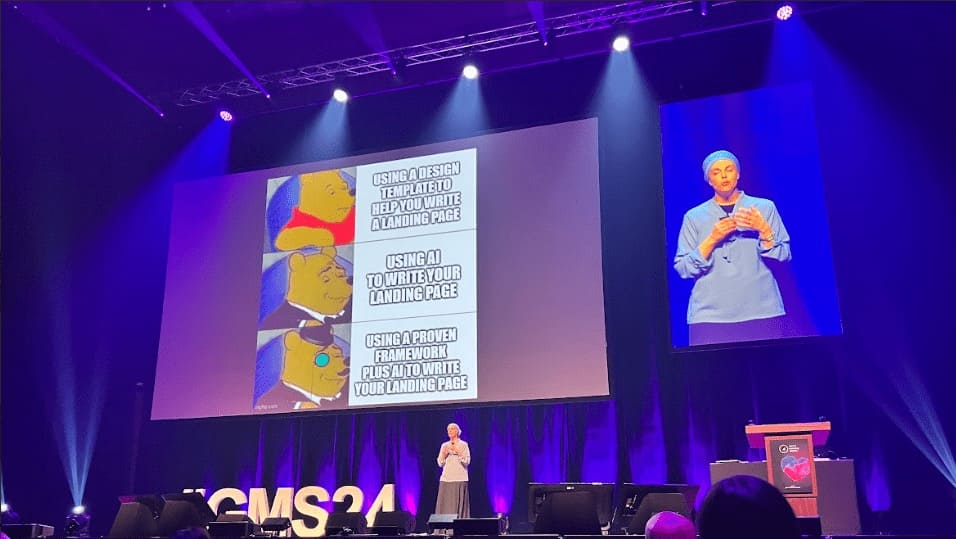
11. I Have Seen The AI Powered Future of CRO and It’s Bright
Speaker: John Ekman, Chief Conversionista at Conversionista!
John’s closing keynote highlighted the transformative role of AI in CRO. He emphasised that understanding the generative AI basics is crucial for leveraging its potential – echoing Ioana’s point on accessibility through understanding. John explained that AI, particularly large language models (LLMs), predicts the next word or action in a sequence.
John pointed out how AI can streamline tedious tasks, such as creating campaign pages or generating reports, enhancing efficiency. He used the Double Diamond model to illustrate how AI excels in divergent thinking, expanding problem understanding, while human insight remains crucial for converging on optimal solutions.
He provided an example of a company using AI to predict office relocations by analysing real estate listings and news articles. They coined this system ‘Bloodline AI’ – as it drips leads into their inbox every day. This predictive capability allowed the company to preemptively target potential customers and grow its reach.
Looking forward, John predicted a seismic change in the role of websites. With referral traffic from Google expected to plummet, websites must pivot to influencing AI-generated answers and delivering personalised content.
John concluded by urging the audience to embrace AI for both efficiency and exploration, moving from execution to strategic roles, ensuring CRO adapts to the evolving digital landscape.
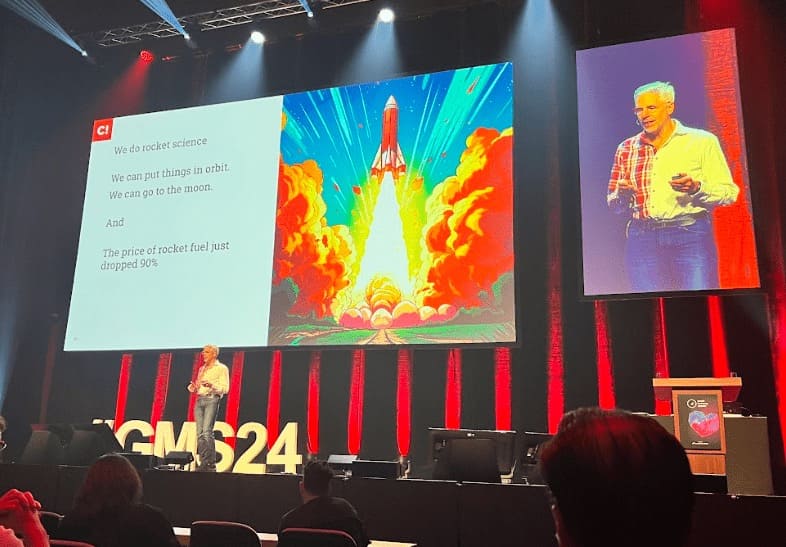
Parting Thoughts
Held in the beautiful Alte Oper concert hall, the Growth Marketing Summit (GMS) was a feast for the mind.
Some themes that hit home:
- Human-centric design as the North Star of product management
- AI can be very useful for minimising grunt work and enhancing creativity
- Making data accessible to all team members will lead to more informed decisions across the board
- Aligning experimentation with business objectives and getting leadership buy-in cannot be an afterthought.
I came away with a robust set of practical tools to try. Michael and Sean shared ready-to-use user and market research questions, while Eden unveiled her WIIFM framework for crafting effective messages, even for those new to copywriting. Insights and knowledge from this year’s GMS will undoubtedly inspire and influence our strategies in the coming months. I’m already looking forward to next year!
Written By
Marcella Sullivan

Edited By
Carmen Apostu


